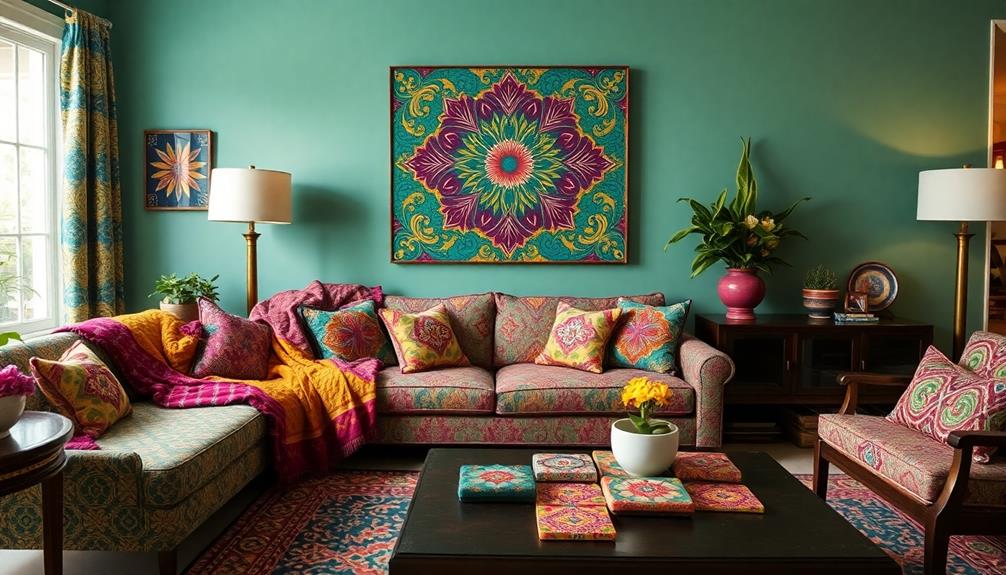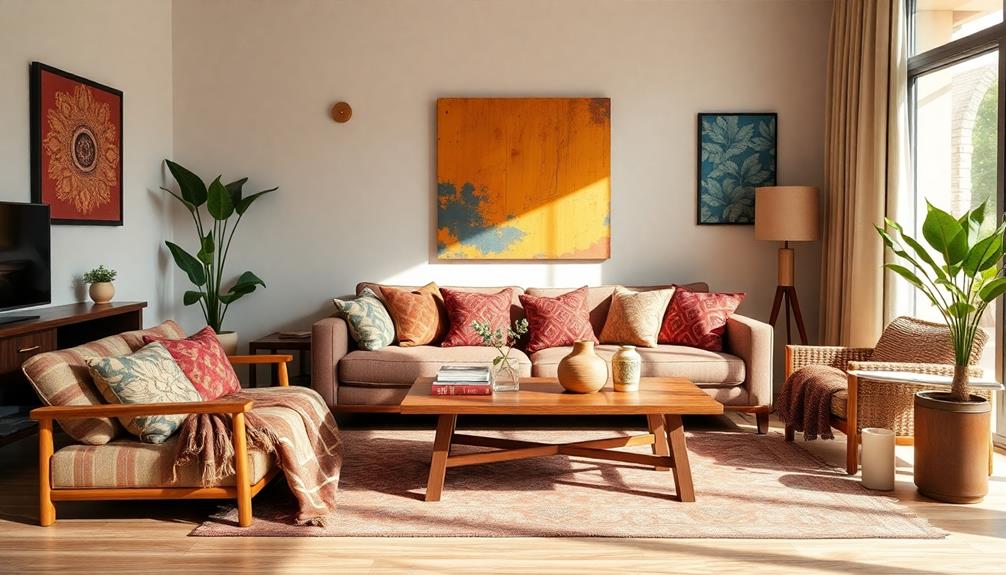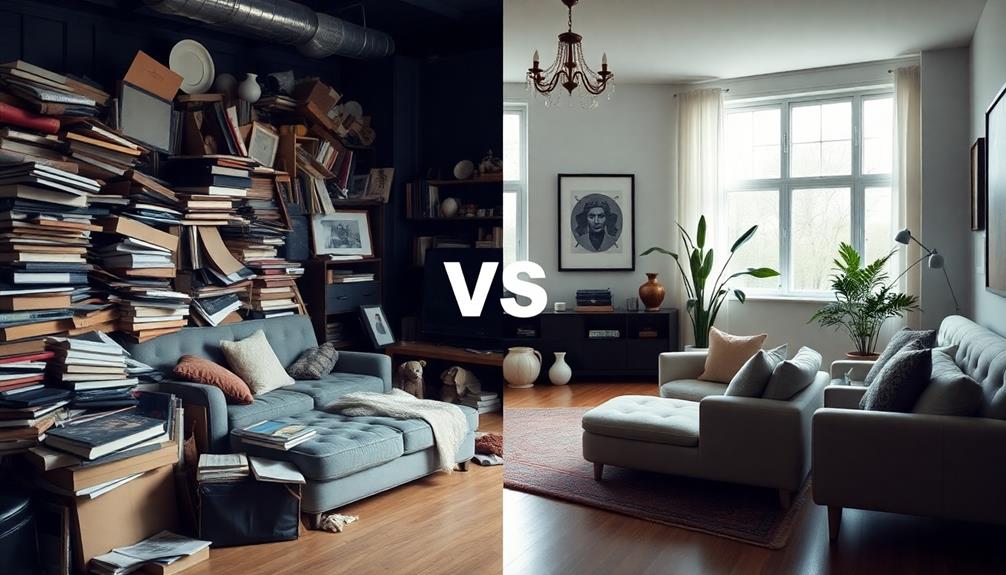Integrating batik into your modern home decor adds a touch of cultural elegance that's hard to replicate. You'll find that batik's intricate patterns and vibrant colors serve as striking statement pieces, from large tapestries to accent cushions. This unique art form tells stories of heritage and identity, bridging traditional craftsmanship with contemporary aesthetics. You can easily blend these timeless motifs with your existing decor, evoking rich cultural narratives. Embracing batik not only enhances your space but fosters meaningful conversations too. There's so much more to explore about this enchanting art form and its significance in home decor.
Key Takeaways
- Batik's intricate patterns and vibrant colors serve as striking statement pieces, enhancing the elegance of modern home decor.
- Incorporating batik into decor fosters meaningful conversations by sharing cultural stories and heritage.
- Batik blends traditional craftsmanship with contemporary design, creating harmony in diverse aesthetic styles.
- Each batik piece reflects regional variations, showcasing Indonesia's rich cultural heritage and artistry.
- Batik not only decorates spaces but also symbolizes identity and pride, connecting individuals to their cultural roots.
Tracing Batik's Ancestral Roots

Batik, with its vibrant patterns and rich textures, isn't just fabric; it's a tapestry woven from over 2000 years of history. When you investigate the roots of batik heritage, you discover its deep connections to Southeast Asia, where the ancient wax-resist dyeing technique began.
While its origins are debated, you can trace its influence back to regions like Africa, India, Sri Lanka, and China, showcasing a global tapestry of artistry. The appreciation for traditional craftsmanship, similar to the love for Indonesian decor masks, is evident in the way batik is celebrated in modern decor.
Java stands out as a pivotal region where batik flourished, thanks to its natural resources like cotton and beeswax. As you explore the intricate designs, you'll notice distinct regional patterns reflecting the diverse cultural influences across Indonesia. Each piece of batik tells a story, embodying the artistry and traditions of its people.
Through migration and Dutch colonization, batik spread far beyond its origins, making its way to Europe and neighboring countries like Malaysia and Myanmar. In 2009, UNESCO recognized batik as a Masterpiece of Oral and Intangible Heritage, underscoring its significance.
Embracing batik heritage today means celebrating not just a craft, but a rich cultural legacy that continues to inspire.
Defining the Batik Technique

Batik is a fascinating wax-resist dyeing technique that you can appreciate for its intricate patterns and cultural depth.
The artistry involved in creating batik is similar to that seen in traditional artistry of Indonesian decor masks, where each piece tells a story rooted in local heritage.
By applying molten wax to the fabric, artisans create designs that tell stories rooted in their local heritage.
Understanding this traditional method gives you insight into the artistry and significance of each unique piece.
Traditional Wax-Resist Method
The traditional wax-resist dyeing technique, known for its intricate artistry, has roots deep in Indonesian culture. This craftsmanship not only produces stunning patterns but also reflects the rich heritage of Indonesian decorative pillows that enhance living spaces.
When you engage with this method, you apply molten wax to fabric using a canting or stamps before dyeing. This process allows you to create stunning designs through multiple applications of wax and dye, reflecting the artisan's skill and creativity.
Using the canting tool, which dates back to the mid-18th century, you can achieve detailed wax applications for fine patterns. For larger designs, the copper block stamps, or cap, are often employed to cover more extensive areas efficiently.
Authentic traditional batik production is labor-intensive; it requires washing, soaking, and beating the cloth before you can even start the wax application process.
In 2009, UNESCO recognized batik as a Masterpiece of Oral and Intangible Heritage of Humanity, underscoring its cultural significance and the traditional craftsmanship behind it.
As you appreciate the beauty of traditional batik, you're not just admiring fabric; you're engaging with a rich cultural legacy that continues to thrive in modern homes.
Patterns and Cultural Significance
When you explore the world of batik, you'll discover a stunning array of patterns that carry profound cultural meanings. Batik is more than just a beautiful fabric; it's a canvas that tells stories through its intricate designs, often reminiscent of traditional Indonesian style home decor that emphasizes harmony and natural elements.
These batik motifs, created using traditional techniques like Batik Tulis (hand-drawn) and Batik Cap (stamped), reflect the essence of Indonesian culture and artistry. Each design has a unique significance. For instance, the "Megamendung" motif from Cirebon symbolizes clouds and is often associated with luck and protection. Such patterns aren't just decorative; they serve as a connection to identity and heritage, transcending mere aesthetics.
Moreover, regional variations in batik motifs can indicate geographical origins, enriching the cultural narrative behind each piece. UNESCO's recognition of batik as a Masterpiece of Oral and Intangible Heritage emphasizes its importance in preserving traditional craftsmanship.
Types of Batik Explained

How do the various types of batik differ with respect to technique and artistry? Each type showcases unique craftsmanship that reflects Indonesia's rich cultural heritage. You'll find Batik Tulis, Batik Cap, and Batik Lukis, each with its own distinct process and artistic expression.
| Batik Type | Technique Description |
|---|---|
| Batik Tulis | Hand-drawn, labor-intensive, unique pieces, takes weeks to years. |
| Batik Cap | Stamped using copper tools for faster, uniform designs. |
| Batik Lukis | Painted designs allowing creative freedom, less time-consuming. |
Batik Tulis is the most traditional form, where artisans painstakingly create intricate patterns, making each piece a true work of art. Batik Cap, on the other hand, employs a faster stamping method, making it more accessible for everyday use. Finally, Batik Lukis offers modern artists a canvas for creativity, aligning with contemporary fashion trends.
Both Batik Tulis and Batik Cap have earned UNESCO recognition, emphasizing their cultural significance. The diversity of techniques not only showcases the evolution of batik craftsmanship but also enriches the cultural tapestry of Indonesia.
Batik's Influence on Home Decor

Batik can transform your home decor by acting as striking statement pieces that grab attention. Its versatility allows you to seamlessly incorporate batik as accent elements in any style, enriching your space with vibrant patterns.
Additionally, similar to the importance of Indonesian decor masks, batik embodies rich cultural heritage that enhances the aesthetic and storytelling aspects of your home.
Plus, the cultural stories behind each piece invite meaningful conversations and add depth to your living environment.
Statement Pieces Design
Transforming your living space with batik can create striking statement pieces that elevate your home decor. Batik's intricate patterns and vibrant colors make it a perfect choice for statement furniture, like upholstered chairs and sofas. These pieces add a touch of cultural elegance that stands out in any room, while also reflecting the natural materials and craftsmanship characteristic of Balinese design.
You can also use large batik tapestries as stunning focal points, showcasing the artistry and heritage of this traditional craft while enhancing overall decor. The versatility of batik allows it to blend seamlessly with various styles, whether you're going for a contemporary feel or a more traditional aesthetic.
Incorporating batik into accent pieces like throws, cushions, and lampshades provides unique touches that celebrate traditional craftsmanship in your everyday living. Each batik item you choose not only enhances visual appeal but also fosters appreciation for its cultural significance and the artisanal skills behind the craft.
Versatile Accent Elements
Incorporating batik into your home decor goes beyond just statement furniture; it can enhance the ambiance with versatile accent elements that resonate with your personal style. Batik's diverse designs allow it to fit seamlessly into various decor styles, whether you lean towards traditional or contemporary aesthetics.
Additionally, exploring local shops for unique batik pieces can lead to discovering tropical home decor that beautifully complements your batik selections.
Consider using large batik tapestries as focal points in your living space. They not only add visual interest but also carry deep cultural significance, celebrating Indonesia's rich cultural heritage.
You can also explore batik throws and cushions to infuse warmth and character into your modern home. These accent pieces highlight traditional craftsmanship while ensuring comfort and style.
The versatility of batik allows it to harmonize beautifully with other decor elements. Mix and match batik items with your existing decor to create a layered and inviting atmosphere.
Each piece tells a story, enriching your space with intricate artistry that invites admiration. By thoughtfully incorporating batik accents, you foster a deeper appreciation for cultural heritage while creating a home that reflects your unique taste and personality.
Embrace the charm of batik and let it transform your living environment into a canvas of elegance.
Cultural Storytelling Through Decor
Through the lens of home decor, batik serves as a vibrant storyteller, weaving tales of Indonesia's rich cultural heritage into your living space. Each batik pattern reflects distinct regional motifs, turning your home into a canvas of cultural dialogue.
By incorporating elements from traditional Indonesian housing, such as elevated structures or local materials, you can further enhance the authenticity of your decor. When you incorporate batik into furnishings like cushions or wall art, you blend traditional craftsmanship with modern aesthetics, creating a unique and inviting atmosphere.
The intricate designs and vibrant colors of batik harmonize effortlessly with various decor styles, whether you lean toward traditional or contemporary themes. By using batik as accent pieces—like table runners, curtains, or throw pillows—you infuse warmth and cultural depth into your living areas, showcasing artisanal artistry that captivates guests.
Moreover, batik doesn't just enhance visual interest; it tells a story of heritage and identity, fostering a deeper connection to Indonesian culture. As you curate your space, let batik be more than just decor; let it narrate the rich history and artistry that it embodies.
In doing so, your home becomes a reflection of both personal style and cultural appreciation, celebrating the beauty of diversity through elegant storytelling.
Blending Traditional and Modern Styles

By seamlessly blending batik with modern design elements, you can create a home that celebrates both tradition and contemporary aesthetics. The intricate patterns of batik not only add visual interest but also serve as a bridge between old and new.
Incorporating traditional motifs and patterns can enhance the cultural significance of your decor. You might be surprised at how versatile batik can be, fitting effortlessly into various styles from minimalist to bohemian.
Here are a few ways to incorporate batik into your space:
- Focal Points: Use large batik tapestries as stunning focal points in living areas, drawing the eye and sparking conversation.
- Accent Decor: Add smaller batik pieces like throw pillows or framed art to complement your existing decor, enhancing the overall aesthetic.
- Contemporary Harmony: Choose batik patterns that harmonize with modern furniture and accessories, merging traditional artistry with contemporary design.
Incorporating batik into your home design not only showcases its intricate beauty but also fosters appreciation for traditional craftsmanship.
This blend of cultural heritage and modern living enriches your space, creating a unique narrative that resonates with both you and your guests.
Cultural Significance of Batik

The rich cultural significance of batik extends far beyond its aesthetic appeal, weaving a tapestry of history and identity that resonates deeply within Indonesian society.
As you explore batik, you'll discover it isn't just fabric; it's a profound expression of oral and intangible heritage. Each motif tells a story, encapsulating the values and beliefs of generations past. Incorporating traditional Indonesian wedding decor ideas can enhance the celebration of this art form.
Traditionally, batik served as a cultural identifier, marking significant life events, especially in wedding ceremonies, and distinguishing social castes. For instance, the "Batik parang" design, reminiscent of daggers, symbolizes royal heritage and class distinction.
As you investigate further, you'll see how various patterns represent different provinces, allowing you to trace their geographical origins and cultural contexts.
Batik's importance transcends its traditional roles, fostering a sense of pride among Indonesians, even those living abroad.
Regional Variations in Batik

Batik showcases an incredible array of regional variations, each uniquely reflecting the local culture and natural elements of Indonesia. When you explore these variations, you'll notice that the motifs and techniques differ vastly from one region to another, allowing you to appreciate the rich tapestry of Indonesia's heritage.
- The "Megamendung" motif from Cirebon symbolizes clouds, characterized by flowing lines and vibrant colors.
- The "Batik parang," with its dagger-like rows, is steeped in historical significance and was once reserved for the elite.
- Each region's batik patterns serve as identifiers, enabling you to trace the fabric back to specific provinces based on its unique design.
These regional variations in batik not only highlight the artistry and craftsmanship involved but also embody the cultural significance and storytelling traditions that have been passed down through generations.
As you incorporate batik into your modern home, you're not just choosing a beautiful fabric; you're embracing a piece of Indonesia's diverse cultural narrative. Each design tells a story, inviting you to celebrate the heritage and creativity that make batik a timeless treasure.
Batik as a Symbol of Identity

For many Indonesians, especially those living abroad, wearing batik is more than just a fashion choice; it's a heartfelt connection to their cultural roots. When you don those intricate batik designs, you're not just showcasing beautiful fabric; you're embracing a powerful representation of your identity. Each motif often signifies specific regions in Indonesia, allowing you to express your heritage and provincial pride.
Batik fosters a sense of recognition and camaraderie among Indonesians globally. When you wear it, it acts as a visual reminder of shared cultural values and traditions, instantly connecting you with others who appreciate this rich art form. The historical significance of batik, coupled with its artistic expression, embodies pride in Indonesian culture.
Moreover, as you incorporate batik into your wardrobe or home decor, you enhance its role as a medium for cultural storytelling and personal expression. Whether it's a vibrant batik shirt or elegant curtains adorned with traditional patterns, these designs serve as a symbol of your roots, continually reminding you and those around you of the beauty and depth of Indonesia's cultural heritage.
Sustainable Practices in Batik Production

Sustainable practices in batik production are reshaping the industry by prioritizing eco-friendly techniques and ethical sourcing.
By focusing on these methods, you can enjoy beautiful batik pieces that also honor the environment and local communities. Many brands, like Kapten Batik, are leading the charge in responsible production, ensuring that their practices support both artisans and the planet.
Here are some key aspects of sustainable practices in batik production:
- Natural Dyes: Utilizing dyes derived from local plants reduces pollution and strengthens cultural ties to traditional batik making.
- Waste Reduction: Emphasizing careful planning and minimalistic designs helps minimize waste, creating a more efficient production process.
- Recycled Textiles: Incorporating recycled fabrics and sustainable materials like cotton and Tencel leads to environmentally friendly fashion options.
Batik in Contemporary Fashion

Often celebrated for its vibrant patterns and rich cultural heritage, batik is making waves in contemporary fashion. Designers are blending traditional motifs with modern flair, creating versatile pieces that fit effortlessly into your wardrobe. You'll find chic dresses and stylish tops that work for both casual outings and formal events.
| Style | Description | Pairing Suggestions |
|---|---|---|
| Batik Dresses | Elegant designs with traditional patterns | Strappy sandals or heels |
| Batik Tops | Modern silhouettes showcasing batik prints | Denim jeans or tailored trousers |
| Batik Skirts | Flowy and fashionable, perfect for layering | Off-shoulder tops or fitted blouses |
| Batik Accessories | Scarves, shawls, and handbags enhance outfits | Statement jewelry for a chic touch |
Key trends include mixing batik with contemporary elements, like pairing batik skirts with trendy off-shoulder tops. Accessories featuring batik patterns bring a cultural flair to everyday wear, allowing you to celebrate diversity while supporting artisans. This resurgence not only honors tradition but also makes batik appealing to a broader audience, redefining the landscape of modern fashion.
Frequently Asked Questions
What Is the Culture Behind Batik?
Batik embodies a rich cultural heritage, reflecting local traditions and nature through intricate designs. You'll find that each motif tells a story, connecting you to Indonesia's diverse history and its significance in society.
What Is the Basis of Modern Batik Design?
Isn't it fascinating how modern batik design blends traditional motifs with contemporary styles? Designers use innovative methods and sustainable materials, creating versatile pieces that celebrate cultural heritage while appealing to today's aesthetic sensibilities.
Is Batik a Tradition?
Yes, batik is a rich tradition rooted in Southeast Asian culture. You'll find its intricate designs and meanings reflect history, social status, and local narratives, making it a vibrant expression of cultural identity through generations.
Conclusion
Incorporating batik into your home isn't just a design choice; it's a gentle nod to a rich cultural heritage that whispers stories of the past. By blending traditional artistry with modern aesthetics, you create a space that speaks volumes about your identity and values. As you embrace this elegant fabric, you're not just decorating—you're weaving a tapestry of history, sustainability, and style. Let your home be a canvas where tradition meets contemporary flair, celebrating the beauty of batik.









